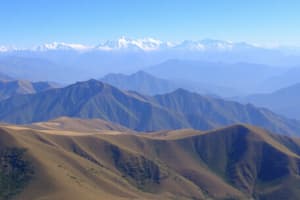Podcast
Questions and Answers
Which geographical feature is known for being highly fertile and densely populated in India?
Which geographical feature is known for being highly fertile and densely populated in India?
- Western Ghats
- Himalayas
- Indo-Gangetic Plain (correct)
- Thar Desert
Which river is known to join the Ganges and forms the world's largest delta?
Which river is known to join the Ganges and forms the world's largest delta?
- Godavari
- Brahmaputra (correct)
- Indus
- Krishna
What is the significance of the Himalayas in terms of climate impact?
What is the significance of the Himalayas in terms of climate impact?
- They increase temperatures in the southern parts of India.
- They provide water flow directly to the Arabian Sea.
- They act as a barrier to cold winds from the north. (correct)
- They enhance rainfall in the eastern regions.
Which of the following is NOT a major river in India?
Which of the following is NOT a major river in India?
Which mountain range runs parallel to the western coast of India and is recognized as a UNESCO World Heritage site?
Which mountain range runs parallel to the western coast of India and is recognized as a UNESCO World Heritage site?
Which river flows westward and drains into the Arabian Sea?
Which river flows westward and drains into the Arabian Sea?
Which of these regions is identified as having the oldest mountain range in India?
Which of these regions is identified as having the oldest mountain range in India?
What type of climate is primarily found in southern India?
What type of climate is primarily found in southern India?
Flashcards are hidden until you start studying
Study Notes
Geographical Diversity
- India spans approximately 3.287 million square kilometers, making it the seventh-largest country in the world.
- The country features diverse geographical regions, including:
- Plains: The Indo-Gangetic Plain, fertile and densely populated.
- Deserts: The Thar Desert in the northwest.
- Coastal Regions: Long coastline along the Arabian Sea and Bay of Bengal.
- Islands: Andaman and Nicobar Islands in the southeast, Lakshadweep in the southwest.
- Climate Zones: Ranges from tropical in the south to temperate in the north.
Major Rivers
- Ganges (Ganga):
- Originates from the Gangotri Glacier.
- Sacred river with significant cultural and religious importance.
- Brahmaputra:
- Flows through the northeast, known for its strong currents and flooding.
- Joins the Ganges to form the world's largest delta.
- Indus:
- Flows through northern India and into Pakistan.
- Vital for irrigation and agriculture in Punjab region.
- Godavari and Krishna:
- Major peninsular rivers flowing eastward into the Bay of Bengal.
- Narmada and Tapi:
- West-flowing rivers that drain into the Arabian Sea.
Mountain Ranges
- Himalayas:
- Youngest and highest mountain range in the world, including peaks like Mount Everest.
- Acts as a barrier to cold winds from the north and affects climate.
- Western Ghats:
- Runs parallel to the western coast; a UNESCO World Heritage site.
- Rich in biodiversity and home to numerous endemic species.
- Eastern Ghats:
- Discontinuous range along the eastern coast; less elevated than the Western Ghats.
- Aravalli Range:
- One of the oldest mountain ranges in India, running across Rajasthan.
- Important for mineral resources and biodiversity.
- Vindhya Range:
- Located in central India, separating northern and southern India.
Geographical Diversity
- India covers around 3.287 million square kilometers, ranking as the seventh-largest country globally.
- Features a variety of geographical regions:
- Plains: The Indo-Gangetic Plain is notable for its fertility and high population density.
- Deserts: The Thar Desert is located in the northwest, characterized by arid conditions.
- Coastal Regions: Boasts an extensive coastline along the Arabian Sea and Bay of Bengal, which is crucial for trade.
- Islands: Includes the Andaman and Nicobar Islands to the southeast and Lakshadweep to the southwest, known for their biodiversity and tourism.
- Climate Zones: Experiences a wide range of climates from tropical in the south to temperate in the north.
Major Rivers
- Ganges (Ganga):
- Starts from the Gangotri Glacier, regarded as a sacred river with deep cultural and religious significance in Hinduism.
- Brahmaputra:
- Flows through northeastern India; noted for powerful currents and flooding, ultimately merging with the Ganges to form the world's largest delta, the Sundarbans.
- Indus:
- Traverses northern India and Pakistan, essential for irrigation and agriculture, particularly in the fertile region of Punjab.
- Godavari and Krishna:
- Significant rivers in peninsular India, flowing eastward into the Bay of Bengal, supporting agriculture and ecology.
- Narmada and Tapi:
- West-flowing rivers that empty into the Arabian Sea, important for surrounding ecosystems and irrigation.
Mountain Ranges
- Himalayas:
- The youngest and tallest mountain range in the world, home to Mount Everest, affecting climate by blocking cold northern winds.
- Western Ghats:
- A UNESCO World Heritage site along the western coast, significant for remarkable biodiversity and numerous endemic species.
- Eastern Ghats:
- A discontinuous mountain range along the eastern coast, generally lower in elevation compared to the Western Ghats.
- Aravalli Range:
- One of India's oldest ranges, stretching across Rajasthan, important for its mineral resources and diverse wildlife.
- Vindhya Range:
- Situated in central India, serving as a natural division between northern and southern India.
Studying That Suits You
Use AI to generate personalized quizzes and flashcards to suit your learning preferences.




